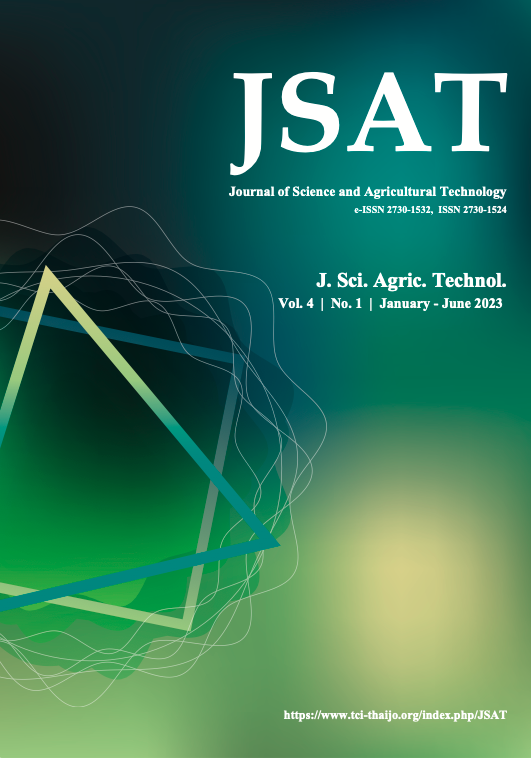Effect of cross-inbred lines and supplementation of brewed ground corn on the productivity and carcass quality of black pig
Main Article Content
Abstract
The analysis of variance was used to evaluate the datasets, and the means were compared using Duncan's new multiple-range test. Data indicated that pigs had substantially higher body weight gain but lower feed conversion and feed cost per gain than L1L1 and L1L3. Carcass percentage and some characteristics such as pH, temperature, pork color, and drip loss were not substantially different between the three black pig cross-inbred lines (P>0.05). The LSQ index and back fat thickness showed that three sets of black pigs had moderate lean and fat percentages. The BGC supplementation may increase feed intake. On the other hand, it has no discernible effect on growth rate, carcass characteristics, or quality. The L1L3black pig demonstrated excellent growth efficiency, decent quality pork, and carcass percentage. However, BGC supplementation has no discernible effect on growth rate, carcass characteristics, or quality. The L1L3 black pig demonstrated great efficiency of growth performance, acceptable quality pork, and carcass percentage. The L1L3 can be the priority option and can be implied for improving the pig output of small farmers in Nan Province. The BGC supplementation at the rate of 1.0 percent of body weight/day may increase the feed intake while not affecting black pig growth or carcass.
Article Details

This work is licensed under a Creative Commons Attribution-NonCommercial-NoDerivatives 4.0 International License.
References
Ano, Y., You Li, J., Jomoto, T., Kurihara, D., Nishimura, R., Nakayama, H., and Kuwahara, M. 2020. Distillation remnants of shochu, a traditional Japanese liquor, improve pork meat quality by reducing stress. Food Chemistry. 318: 126488.https://doi.org/10.1016/j.foodchem.2020.126488Get rights and content.
BAHG. 2005. Chiangmai Black Pigs. Department of Livestock Development, Bangkok. (in Thai)
Charoensook, R., Gatphayak, K., Brenig, B., and Knorr, C. 2019. Genetic diversity analysis of Thai indigenous pig population using microsatellite markers. Asian-Australasian J. Anim. Sci. 32(10): 1491-1500.
Chomchai, S., Tubcharoen, S., Sookmanee, N., Kanto, U., Chantsawang, S., and Mata, N. 1998. Production performance of tested pigs at Kampaengsaen central testing station from the first to the eight testing. In: Proceedings of the 36th Kasetsart University Annual Conference. p. 1-8.
Homma, C., Hirose, K., Ito, T., Kamikawa, M., Toma, S., Nikaido, S., Satoh, M., Uemoto, Y. 2021. Estimation of genetic parameter for feed efficiency and resilience traits in three pig breeds. Animal. 15(11): 100384.
Kuha, K., Toemsombatthaworn, P., and Changkleungdee, S. 2012. Effects on pig behavior, stress and carcass characteristics of a short-term diet with high levels of L-tryptophan. KMUTT Research and Development Journal. 35(1):16-29.
Pfeiffer, H. and Falkenberg, H. 1972. Masse am lendenlspiegel zur objektiven ermittlung der schlachtlkorperzusammensetzung bei schwein. Tierzucht. 26: 466-467.
Rocadembosch, J., Amador, J., Bernaus, J., Font, J., and Fraile, L. J. 2016. Production parameters and pig production cost: temporal evolution 2010-2014. Porcine Health Management. 2:11. https://doi.org/10.1186/s40813-016-0027-0.
SAS. 1999. SAS user's guide: Statistics (Version 8.01 ed.). SAS Inst. Inc., Cary, N.C.
Sethakul, J., Tuntivisoottikul, K., and Sitthigripong, R. 2003. Grading of pig carcass by using LSQ. Agricultural Science Journal. 34: 4-6 (Suppl.): 228-231. (in Thai)
Srikanchai, T., Jaturasitha, S., Phongpiachan, P., and Rattanapanone, V. 2005. Effects of dietary fish oil, sexes and slaughtered weights on productive performance and carcass quality of growing-finishing pigs. Kamphaeng Saen Academic Journal. 3(3): 20-31.
Suzuki, M., Masuda, T., Kawamoto, T., Tajima, S., Uchikura, K., and Kurita, T. 2018. Effects of feeding liquid brewer’s yeast on growth performance, carcass characteristics, and meat quality of finishing pigs. J. Swine Science. 56(2): 23-32.
TACFS, 2004. Thai agricultural commodity and food standard: Pork (TACFS 6000-2004: Pork). Bangkok, www.acfs.go.th.
Tungtrakoolsub, P. 2013. Production performances of GGP purebred pigs in Tubkwang Research Station. In: Proceedings of the the 10th Kasetsart University, Kamphaeng Saen campus Confference. p. 3150-3157. (in Thai) AS user's guide: Statistics (Version 8.01 ed.). SAS Inst. Inc., Cary, N.C.


